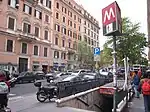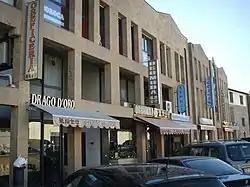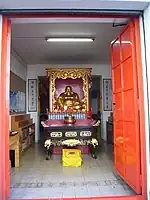| Total population | |
|---|---|
| 330,495 (2020) 0.53% of the Italian population | |
| Regions with significant populations | |
| Languages | |
| Wenzhounese · Mandarin Chinese · Italian | |
| Religion | |
| Chinese folk religion, Buddhism, Christianity | |
| Related ethnic groups | |
| Overseas Chinese |
| Chinese Italian | |||||||||||
|---|---|---|---|---|---|---|---|---|---|---|---|
| Traditional Chinese | 意大利華人 | ||||||||||
| Simplified Chinese | 意大利华人 | ||||||||||
| |||||||||||
| Alternative Chinese name | |||||||||||
| Traditional Chinese | 意大利華僑 | ||||||||||
| Simplified Chinese | 意大利华侨 | ||||||||||
| |||||||||||
The community of Chinese people in Italy has grown rapidly in the past ten years. Official statistics indicate there are at least 330,495 Chinese citizens in Italy, although these figures do not account for former Chinese citizens who have acquired Italian nationality or Italian-born people of Chinese descent.[1]
Demographics
Prato, Tuscany has the largest concentration of Chinese people in Italy and all of Europe. It has the second largest population of Chinese people overall in Italy after Milan.[2]
Religion
Religion of Chinese in Italy (2010)
In total, approximately one quarter of the Chinese community was classified as belonging to the Chinese (folk) religion.[3] The surveyors weren't able to determine a precise Taoist identity; only 1.1% of the surveyed people identified as such, and the analysts preferred to consider Taoism as an "affluent" of the Chinese religion.[4] The survey found that 39.9% of the Chinese had a thoroughly atheist identity, not believing in any god, nor belonging to any religious organisation, nor practicing any religious activity.[5]
The study also analysed the Chinese Christian community, finding it comprised 8% of the total population (of which 3.6% were Catholics, 3.3% Protestants and 1.1% Jehovah's Witnesses). The Christian community was small, but larger than that of the province of origin, especially for the Catholics and the Jehovah's Witnesses, the latter being an illegal religion in China.[6] Protestants were found to be basically nondenominational and largely (70%) women.[7]
In the years 2011 and 2012 the ISTAT made a survey regarding the religious affiliation among the immigrants in Italy, the religion of the Chinese people in Italy were as follows:[8]
- Non religious: 44.5%
- Buddhists: 44.4%
- Christians: 7.3%
- Other religions: 3.8%
Community relations
In 2007, several dozen protesters took to the streets in Milan over alleged discrimination.[9] The northern Italian town of Treviso also ordered Chinese-run businesses to take down their lanterns because they looked "too oriental".[10]
Cities with significant Chinese communities


Based on Demo ISTAT statistics.
- Milan 18,918 (1.43% on total resident population)
- Rome 12,013
- Prato 11,882 (6.32%)
- Turin 5,437
- Florence 3,890 (1.05%)
- Campi Bisenzio 3,018 (6.87%)
- Reggio Emilia 2,925 (1.72%)
- Bologna 2,654
- Naples 2,456
- Brescia 2,394 (1.23%)
- Venice 2,163
- Empoli 1,759 (3.67%)
- Genoa 1,637
- Forlì 1,607 (1.36%)
- Padua 1,571
- Fucecchio 1,502 (6.39%)
The city of Prato has the second largest Chinese immigrant population in Italy (after Milan with Italy's largest Chinatown). Legal Chinese residents in Prato on 31 December 2008 were 9,927.[11] Local authorities estimate the number of Chinese citizens living in Prato to be around 45,000, illegal immigrants included.[12] Most overseas Chinese come from the city of Wenzhou in the province of Zhejiang, some of them having moved from the Chinatown in Paris. In 2021 there were 33871 (2,466%) Chinese in Milan and 33649 (16,764%) in Prato[13]
Notable people
References
- ↑ National Institute of Statistics (Italy): I cittadini non comunitari regolarmente soggiornanti Archived November 13, 2014, at the Wayback Machine. Retrieved 5 January 2015.
- ↑ Donadio, Rachel (2010-09-12), "Chinese Remake the 'Made in Italy' Fashion Label", The New York Times, retrieved 2011-05-04
- ↑ Pierluigi Zoccatelli; Religione e religiosità fra i cinesi a Torino. "Religione cinese", identità secolare e presenze di origine cristiana. In: Luigi Berzano, Carlo Genova, Massimo Introvigne, Roberta Ricucci, Pierluigi Zoccatelli; Cinesi a Torino: la crescita di un arcipelago; Il Mulino, 2010. ISBN 9788815137913. pp. 222-223: «L'atteggiamento religioso che classifichiamo qui come "religione cinese" corrisponde a circa un quarto del campione [...]».
- ↑ Pierluigi Zoccatelli; Religione e religiosità fra i cinesi a Torino. "Religione cinese", identità secolare e presenze di origine cristiana. In: Luigi Berzano, Carlo Genova, Massimo Introvigne, Roberta Ricucci, Pierluigi Zoccatelli; Cinesi a Torino: la crescita di un arcipelago; Il Mulino, 2010. ISBN 9788815137913. p. 223: «Non abbiamo invece trovato ragioni sufficienti per identificare una specifica identità taoista – in effetti, solo tre intervistati si sono dichiarati esplicitamente taoisti –, e preferiamo considerare il taoismo come un affluente della "religione cinese".»
- ↑ Pierluigi Zoccatelli; Religione e religiosità fra i cinesi a Torino. "Religione cinese", identità secolare e presenze di origine cristiana. In: Luigi Berzano, Carlo Genova, Massimo Introvigne, Roberta Ricucci, Pierluigi Zoccatelli; Cinesi a Torino: la crescita di un arcipelago; Il Mulino, 2010. ISBN 9788815137913. p. 223: «[...] a Torino il 39,9% che congiuntamente si dichiara non religioso, non crede in Dio o in un potere superiore, non crede in una vita dopo la morte, né pratica la divinazione, può essere ascritto a questa identità secolare.»
- ↑ Pierluigi Zoccatelli; Religione e religiosità fra i cinesi a Torino. "Religione cinese", identità secolare e presenze di origine cristiana. In: Luigi Berzano, Carlo Genova, Massimo Introvigne, Roberta Ricucci, Pierluigi Zoccatelli; Cinesi a Torino: la crescita di un arcipelago; Il Mulino, 2010. ISBN 9788815137913. p. 225: «Ne è emersa una presenza non certamente maggioritaria ma, come vedremo nel paragrafo successivo, forse maggiore rispetto a quella delle regioni cinesi di origine. In particolare, appare maggiore la presenza di cattolici e compaiono i Testimoni di Geova, che nella regione da cui provengono la maggioranza dei cinesi di Torino non possono operare legalmente.»
- ↑ Pierluigi Zoccatelli; Religione e religiosità fra i cinesi a Torino. "Religione cinese", identità secolare e presenze di origine cristiana. In: Luigi Berzano, Carlo Genova, Massimo Introvigne, Roberta Ricucci, Pierluigi Zoccatelli; Cinesi a Torino: la crescita di un arcipelago; Il Mulino, 2010. ISBN 9788815137913. p. 227
- 1 2 "Appartenenza e pratica religiosa tra i cittadini stranieri". www.istat.it (in Italian). 2014-10-30. Retrieved 2017-10-22.
- ↑ Willey, David (2007-04-13), "Milan police in Chinatown clash", BBC News, retrieved 2008-04-22
- ↑ "Oriental decor not allowed", Taipei Times, 2007-05-08, retrieved 2008-04-22
- ↑ "Prato in cifre: gli stranieri residenti a Prato – suddivisione per cittadinanza" (in Italian). Comune.prato.it. 31 December 2008. Archived from the original on 24 February 2011. Retrieved 5 April 2011.
- ↑ "Notizie, informazioni della regione Toscana". Intoscana.it. Retrieved 5 April 2011.
- ↑ Cinesi in italia tuttitalia.it
Further reading
- Ceccagno, Antonella (September 2003), "New Chinese Migrants in Italy", International Migration, 41 (3): 187–213, doi:10.1111/1468-2435.00246 (Archive)
- Luigi Berzano, Carlo Genova, Massimo Introvigne, Roberta Ricucci, Pierluigi Zoccatelli. Cinesi a Torino: la crescita di un arcipelago. Il Mulino, 2010. ISBN 9788815137913.
External links
- SPIEGEL Magazine Article about the Chinese in Prato September 7, 2006
